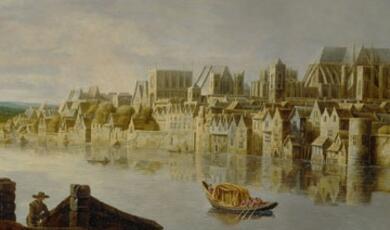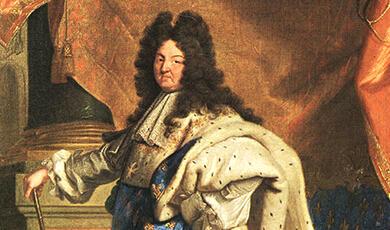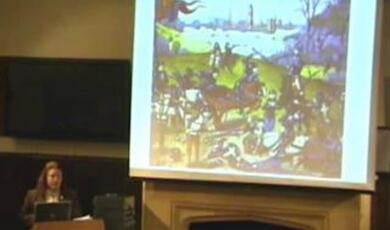The Rise of Consensus, 1650 to 1760
Share
- Details
- Transcript
- Audio
- Downloads
- Extra Reading
Opened up to the world once more England drank in influences and ideas from abroad which were to infuse English building with widely held ideas and values.
This is a part of the lecture series From Architectural Periphery to the World's Engine House: English Building from the Reformation to the First World War.
In this lecture series Simon Thurley continues his investigation into the history of building in England. Starting with the shattering events of the Suppression of the Monasteries and the Civil War he moves on to look at the architectural consensus that briefly reigned in the mid eighteenth century before it dissolved in the white heat of the Industrial Revolution. Economic and technological change then drove English building in remarkable new directions for over 150 years. This period was ended by another shattering event, but this time of global proportions – the First World War. This extraordinary chronicle is not just history of architecture, but the history of an ascendant civilization.
The other lectures in this series include the following:
The End of the Old World Order, 1530-1650
Engine House, 1760-1830
On Top of the World, 1830-1914
Download Transcript
2 November 2011
The Rise of Consensus 1650 to 1760
Professor Simon Thurley
Against the political and dynastic instability of the civil war and restoration, the subsequent crisis of the Glorious revolution of 188 England’s economy was transformed. By 1700, the country was a great power in a way it had never been before. England’s success was underpinned by a host of factors that I just haven’t time to cover in detail tonight, but they were: agricultural productivity, urbanisation, overseas trade, a credit revolution and war. These changes stimulated and were stimulated by building construction of all sorts.
This was cultural shift of huge importance for building in England. Before the civil war the court was the centre of high culture and architectural impetus. By the 1660s the initiative had shifted markedly towards the middle classes, merchants, the gentry, and the middling sort of Englishmen. This is where innovation came from, these people made taste.
In the 1630s the exotic cocktail of traditional forms blended with ornament from prints and sourcebooks that had dominated English architecture began to seem stale and a generation of plainer buildings, reacting against the excesses of the first thirty years of the century began to be built. So look at Forty Hall, Enfield, completed in 1629 for Sir Nicholas Raynton a rich merchant and Lord Mayor of London. Its elevations are very simple only enlivened by corner quoins, two string courses and a simple modillion cornice. Forty Hall is recognisably a different sort of house to those being built just thirty years earlier; the emphasis is on the relationship of window to wall, not on decoration or on the use of classical orders. The roof is no longer lead flats hidden behind a parapet or balustrade; it is hipped - in other words it is a roof that has no gables where all the sides slope down to the wall tops.
This much more minimalist approach to design in town and country cannot simply be seen as a reflection of a bloody civil war leading to a military dictatorship; nor is it easily identifiable with a more simplistic type of religion, although both these factors were its background. These buildings should be seen in counterpoint to the excesses of Jacobean ornament and a thirst for a much plainer more simplified manner of building which relied much more on proportion.
In the development of these buildings the traditional master craftsmen continued to play the central role but to their ranks were added a new type of designer, men who had not come through the traditional apprenticeship route but through more gentlemanly pursuits. The first of these was Inigo Jones, but during the seventeenth century he was followed by men such as Captain William Winde, Henry Bell, William Samwell, Hugh May, Roger Pratt, Christopher Wren and John Vanburgh. These gentlemen might build for themselves, but they designed for their social equals and superiors too.
Most of the gentlemen architects’ active in the 1660s had lived in the Netherlands and others had travelled further field through France or Germany to Italy. The most important of these was Sir Roger Pratt who returned from the continent in 1649 and became the leading designer of the 1660s. Together with a small group of others he invented a distinctive rendition of classical architecture for England. Just three years into the Restoration he designed Kingston Lacy. The house’s north front was divided into three parts, the central section crowned with a pediment. It was raised up on a sub-basement and given a steeply pitched roof with dormers capped with a ballustraded platform and a lantern. There was little in this composition that had not been tried before in England, but proportionally Kingston Lacy was different. The addition of a pediment allowed the façade to be broken up making it less monotonous and the horizontal division of two stories and an attic above a sub-basement made the house less vertical than its metropolitan cousins.
An alternative type of house incorporating orders was designed by Hugh May at Eltham Lodge, Greenwich in 1665. Again much is familiar from before the civil war, but the façade is adorned with four ionic pilasters and a pediment containing a coat of arms supported by swags. The sense of proportion is here too although the façade is much plainer without quoins or string courses. In plan Pratt and May’s houses were double pile with a great central room on axis like that at Charlton House, Greenwich, they contained a principal stair and service stairs and rooms disposed either side. These houses were probably subtly influenced by buildings seen by Pratt and May on the continent, but essentially grew out of the native tradition. They captured the mood of the Restoration and became models for houses that were to dominate England for the next sixty years.
After 1660 Charles II court initially returned to the grand manner of the early Stuarts. John Webb, Inigo Jones’s pupil, succeeded in winning Charles II most important domestic commission, a new palace at Greenwich. The old one had been all but destroyed during the Republic and Charles II wanted to re-establish a palace in the east for the reception of ambassadors. The wing that Webb completed was a magnificent Portland stone composition heavily rusticated with assertive key stones and giant orders redolent of the Banqueting House at Whitehall but politically, economically and stylistically out-of-kilter with the times.
However this building was not without influence and architects would turn to it again in the 1690s as a source of inspiration for a new more assertive type of classicism. It is hard to keep down the English love of surface decoration and this combined with a reaction against the suave minimalist classicism of the Restoration to produce something altogether more spirited. Just as Jacobean excess led in counterpoint to the stripped classicism of Pratt and May so that classicism led to a mannered version of itself that deliberately flouted the rules of classical architecture to create a sense of drama and excitement.
The origins of this revival of interest in the picturesque qualities of architecture comes with Charles II’s rebuilding of Windsor Castle, a commission undertaken by Hugh May. From the outside the new apartments were austere and castle-like, but inside there was an explosion of illusionistic wall painting undertaken between 1674 and 1684 by Antonio Verrio. These were spectacular interiors on the cheap as the rooms themselves were plastered boxes; but they were incredibly effective and soon had imitators at Chatsworth, Derbyshire (1687-96), Burghley House, Lincolnshire (1688-98) and most impressively in Sir James Thornhill’s masterpiece, the Painted Hall at Greenwich Hospital of 1707-14. Of these only at Greenwich did the external architecture begin to match the internal décor. Here Wren and Hawksmoor played with light and scale welcoming visitors in a circular vestibule with giant pilasters and a jutting entablature flooded by light from a dome. From here the main vessel of the hall, lined with more giant pilasters and lit from both sides, opened out. At its end the high table was enclosed in another smaller space via a proscenium-like arch.
At Castle Howard, Yorkshire, Hawksmoor and Sir John Vanburgh had succeeded in introducing such theatrical effects into a country house. Here, in 1702, they started a great central hall covered with a dome supported on four arches each opening to a corridor or a staircase. This, the lavish centrepiece of a very large house, would have not been out of place in a cathedral or a palace. Strange though it may seem this ebullient style was easily transmitted from colossal commissions to domestic structures and was popular in the houses of the gentry. Francis Smith of Warwick was one of the most accomplished designers who built Chicheley Hall, for Sir John Chester. Chicheley with giant pilasters a big door case, heavily lidded windows, florid frieze and a sweeping centrepiece is typical of a very popular type of smaller house that makes fast and loose with the rules of classical architecture to cerate a sense of theatre and exuberance.
In the years around 1714 the sense of drama, richness of silhouette and surface decoration that had been so admired at the turn of the century started to become less fashionable and designers began to give greater emphasis to a faithful and precedent-based rendition of classical architecture based on printed sources. This mood was reinforced by the preferences of the new ruler George I who, in his native Hanover, had promoted a style of architecture inspired by the buildings of the Venito.
In the same years three books were published that, between them, provided inspiration for architects for nearly a century. Giacomo Leoni produced, with George I’s approval; the first English version of Andrea Palladio’s I Quattro Libri Dell’Architettura. Leoni’s book was announced in April 1715 just as another ambitious architectural publishing project was gaining momentum. This was a compendium of views of all the most important country houses in England to be published under the title Vitruvius Britannicus. This book was published by a Scottish architect Colin Campbell who included in it some of his own schemes and views. The one contemporary architect whose work was not included in Vitruvius Britannicus was that of another rival James Gibbs. The direct effect of Gibbs’s exclusion from the three volumes of Vitruvius Britannicus was the publication of his own book of designs A Book of Architecture in 1728. This was the most influential and important English book on architecture of the whole eighteenth century, and the first by a living Englishman of his own designs. The book was expressly designed to provide inspiration for those who had not access to the leading architects of London and as well as engravings of his completed works contained unbuilt designs for whole buildings as well as details.
These three books allowed a vastly wider spectrum of society to participate in architectural debate and to be informed by classical architecture. It became much more fashionable to try and create buildings more faithfully according to rules laid down by Leoni or Gibbs. The fact that so much was now published allowed people to be critical of buildings that somehow did not stand up to the standards set down in the texts. Everyone could now be an armchair critic.
Less so Leoni, but both Campbell and Gibbs practiced what they preached and their buildings were as influential as their books. Colen Campbell went on to design a series of hugely influential country houses the first and largest of which was for Sir Richard Child at Wanstead, Essex (c.1714-20). The house comprised a central block with a giant Corinthian portico approached by stairs that doubled back on themselves. Either side were austere ranges given rhythm and proportion by pedimented windows. This was the first time a freestanding portico had been used on a country house and it was to spawn many imitators.
But this sort of architecture was by no means confined to country houses, everyone from the masters of Oxford Colleges, to town corporations wanted to build like this. So here we have William Kent’s Horseguards in central London, Lord Burlington’s assembly rooms in York James Gibbs’s Senate house in Cambridge, all in styles that strove to be closer to the rules of classical building.
There was one invention that made these buildings look fundamentally different to what had come before, and that was the sash window; the single most important architectural invention of the early eighteenth century. Before the sash window openings were divided by transoms and mullions and contained iron frames that were hinged, known as casements. The first sahes came in immediately after the Restoration, the earliest yet found was in Charles II Newmarket palace built in the 1670s. But very quickly casements were replaced with sashes, and as you can see from this they made a profound difference to the way a building looked.
Early eighteenth century two sliding sashes each three panes wide and high, known as nine over nine square panes of glass with 1½” thick glazing bars
By the 1730s it was becoming more common to have larger panes and thinner glazing bars and most windows were six over six. By the 1790s the slimmest and most elegant were only 5/8” thick.
I now want to move on to discuss London, for, as always in English history, it had an important impact on building across England.
James I was determined to improve the appearance of London as a matter of national prestige and established a Commission to oversee the enforcement of his building proclamations. This became a large and powerful body with the stated purpose to improve the quality of architectural design and urban planning in the capital. The power of the Commission was re-enforced by Charles I who encouraged Indigo Jones to take an active role. Indeed during the 1630s, through the commission and their technical advisor Jones, Charles I effectively nationalised London’s planning.
Of the developments of the 1630s the most architecturally coherent was Covent Garden. This was part of the land between the Ciy and Westminster that had been acquired by the crown after the dissolution and had become the property of an aristocrat. Although it was superficially developed by the 4th Earl of Bedford, the centrepiece, the piazza, was the outcome of a complex financial and legal deal that created a royal square to rival the Place Royal in Paris. The king and his personal architect Inigo Jones took responsibility for the design and the hapless earl had to conform to their expensive tastes. Work began in 1629 and the first houses were let in 1631. The piazza was a long rectangle with houses on its north and east sides while the south side was bounded by the garden of Bedford House. The whole of the west side was taken up by St. Paul’s church and its associated buildings. The houses, designed by Inigo Jones, were modelled on designs in Serlio’s book IV and VII and were raised up on a rusticated arcade. Doric pilasters aligned on the piers separated windows on two floors. There was no parapet, nor gables, but a hipped roof with dormer windows. The whole thing was stuccoed to give the impression of stone. The front door to the houses was under the arcade, there was a parlour and study on the ground floor, a dining and drawing room on the first floor and bedrooms above. A garden at the rear led to a coach house and stable. So much of this was novel that the development must have been very striking and it is not surprising that the earl could command £160 a year in rent. The development quickly became a magnate for the rich and titled and set an entirely new standard for west end housing.
But don’t think for a second that Inigo Jones invented the terrace, because he didn’t. Houses built in a row had a long pedigree in England; by the fourteenth century rows of shops with rooms above were a common sight in London and other large towns. Rows that were predominantly residential were known as rents, a term that persisted until the nineteenth century. A large speculative development promoted by the Rich family at St. Bartholomew’s Fairground in London from 1597 to 1616 resulted in the construction of 175 row houses built by a variety of speculators. One of these houses survives at 74 Long Lane dating from soon after 1598. Its principal elevation to the street is jettied but at the back, approached by a narrow alley, is the entrance to the rooms above via a staircase.
Only a few of these rows were built of brick before the great fire and that is why, of course, in 1666, most of the city of London, built of timber, was destroyed. Five sixths of the City had to be rebuilt anew and thus London, by 1700 was a modern metropolis with up-to-date infrastructure. Fire had, in fact, achieved what the monarchy had failed to do in the preceding sixty five years.
There are a couple of things that are really important about the great fire as far the development of building in England is concerned. First, the Great Fire of London rendered 87 of the City’s 107 churches unusable. It was agreed that 51 should be rebuilt financed by the Coal Tax, an extraordinary commission the likes of which had never been seen in England before. Christopher Wren was appointed to preside and was assisted by the architect Robert Hooke and the Surveyor of Westminster Abbey, Edward Woodroffe. Later three of Wren’s colleagues from the Office of Works, Nicholas Hawksmoor, William Dickinson and John Oliver were recruited. Together these, England’s most talented living designers, worked like a modern architect’s office. Wren presided and set the parameters but the design work was shared out between the various hands.
The overriding liturgical concern was the audibility and visibility of the preacher; it was thought that a preacher’s voice could be heard 50ft in front, 30ft either side and 20ft behind; this gave a maximum size of church 60ft wide and 90ft long. The need to have clear lines of sight meant that obstructions such as pillars were not favoured so large undivided spaces were the goal. Such churches had been built before the Fire; Inigo Jones’s St. Paul’s Covent Garden was the first new church in London since before the reign of Queen Elizabeth and had to grapple with the issue of a new type space for the Anglican tradition. It was a single room with its pulpit being the single most expensive fitting.
Wren took a highly pragmatic approach treating each church, its site, its surviving walls and the preferences of the church wardens distinctively. In this the City churches are a unique European phenomenon, as no stylistic dogma dominated. Each church was composed using a mix of gothic and classical elements and forms largely drawing on existing native traditions. The buildings were designed to be appreciated from the inside as they were built on cramped sites, so externally they were plain with a single show front. Their greatest architectural expression was their towers and steeples. Not one was the same; indeed neighbouring churches were given deliberately contrasting treatments to create an astonishingly varied skyline. The regularisation of the rooflines of domestic buildings meant that London’s skyline was remarkably horizontal, the steeples and eventually the dome of the cathedral punctured this creating the feature most remarked-upon by contemporary tourists.
In 1666 everyone hoped that the cathedral, or at least parts of it would be saved, but it was clear that the damage had been too much. There were several tensions to be resolved in a new design, the ambitions of the city, those of the crown and those of the church. Wren’s preferred solution was for a centralised plan based on a Greek cross, but liturgically this was unacceptable and so the new cathedral rose, like its predecessor, as a Roman cross. Wren and his team of draftsmen and craftsmen were forced to resolve the details as the church rose and the dome was not finalised until 1697 and the west towers until 1704. In this way the design of St. Paul’s was scientific experiment, Wren modifying the elements until he achieved the desired effect. St. Paul’s reveals Wren’s weakness as a designer. Close too the elevations are busy, fussy and crowded; inside it has none of the inspiration of a great gothic cathedral or the theatre of a baroque one. Its principal achievement is as a piece of landscape. The west front is a composition of genius conceived to be revealed as the spectator ascends Ludgate Hill and the dome and towers dignified the monotonous skyline of London. As such the architect achieved his brief; to recreate a sense of pride and confidence in the City after the fire.
The rebuilding of the City after the Fire coupled with the development of the West End had a huge impact on provincial towns. It stimulated of the building trades sucking provincial practitioners in to the capital where ideas and techniques were exchanged and later exported to the provinces. The regular streets of new row houses were quickly copied in provincial towns such as Nottingham and Liverpool; the new London squares too exercised a huge influence. Bristol, England’s second town, was the first to have its own square, Queen Square, built in 1700 - five others were completed by 1784.
While London remained the centre for social display several provincial towns became social hubs for their rural hinterlands. In these hubs a much wider range of people mixed. The social distance of previous centuries was eroded and polite society included anyone who could afford to dress well, converse easily and behave appropriately. This required property and education commodities available to a growing sector of society. The phenomenon that expresses this change most clearly is the rage for assemblies that gripped provincial England for a century after 1720. Assemblies started as gatherings for conversation, cards and tea but quickly expanded to include dancing of both delicate minuets and more rumbustious country dances. Ultimately their success was the winning combination of sex and gambling: assembles were a marriage mart for the young and gambling dens for the established.
It was the Lindsey’s rooms at Bath of 1728 that created a model. Here John Wood the Elder managed to blend a drawing room with a great hall to create a space that could accommodate the musicians in a gallery, a main floor glittering with mirrors arched over by a great coved ceiling from which hung chandeliers. Ancillary to the ball room was a card room and a tea room.
Other buildings where polite society could look and be seen were theatres. In the 1630s the great popularity of the theatre under Elizabeth and James I, which had established seven playhouses in London, was increasingly undermined by religious and moral sensibilities. The stage began to be associated with sin, social unrest and moral laxness attitudes which became official Policy when, in 1642, Parliament banned theatre until the troubles were over. The Globe was destroyed in 1644, the Fortune, Phoenix and Salisbury Court theatres in 1649 and Blackfriars Theatre in 1655.
The opening of the Theatre Royal in Drury Lane on 26 March 1674 heralded a new era in London theatre-going. The new theatre was smaller, it was indoors and the seats were considerably more expensive. Going to theatre became part of the leisure circuit for rich and fashionable society, they went frequently, and they were happy to see the same play time and again. A seat in the pit cost 2s 6d and a seat in one of the boxes 4s. Although the season did not continue into the summer months when polite society decamped from London, there were still around 200 performances a year.
Despite a Theatre Licensing Act of 1737 theatres rapidly multiplied in provincial centres and the template for them was the Theatre Royal. Bristol’s Theatre Royal, begun in 1764, was closely based on drawings of Drury Lane and Liverpool’s theatre was actually named after it. But most provincial theatres were less pretentious, the Playhouse in Richmond, Yorkshire built in by the actor-manager Samuel Butler in 1788 is a rectangular space seating over 200 with a sunken pit, boxes on three sides and a gallery above. Other than turned Doric columns supporting the gallery, all the architectural detail was painted. Travelling companies played at theatres each summer, moving from town to town; in the largest venues such as Bath, productions would come from London.
In all this one town set the pace, Bath. The medicinal properties of Bath spa waters had been recognised for centuries but from 1700 the attractions of the cure became entangled with a new sort of town, a place entirely devoted to the leisure pursuits of the rich. In Bath the English invented the holiday: a period spent away from home and from everyday cares. Beau Nash became Master of Ceremonies in 1704 and single-mindedly set out to transform the social scene. His achievement was to get different social groups to mix and interact politely. Bathing became a secondary and then tertiary activity as assemblies, concerts, balls, promenades and gambling all became established as part of the daily round.
From around 1725 Bath also began to make the fashion in town building. This was largely down to John Wood a builder and surveyor who, after working on speculative developments in London and a country house in Yorkshire, returned to Bath in 1727. From 1729 he applied his London experiences, especially his knowledge of Cavendish and Grosvenor Squares, to the development of Queen Square, Bath. The square was the successful realisation, for the first time, of a speculative development of eight individual houses which at first glance looked like a vast town palace. Residents could bask in an aura of grandeur that their individual dwellings could never convey.
Wood was unusual in that he mixed architectural talent and commercial nous with antiquarian obsession. Even before work started on Queen Square he had conceived a meglomaniac scheme for Bath which would include a ‘royal forum’, a ‘grand circus’ and an ‘Imperial Gymnasium’. The circus of 33 houses was built 1755-67 and entered by three streets none of which aligned across the circus with another. This was important because by closing off vistas it made the internal circle feel private and enclosed. This sense of enclosure is strengthened by the encircling regularity of the facades with paired Doric, Ionic and Corinthian orders separated by vigorous bands of base and entablature and crowned with a parapet studded with giant acorn finials. This was the Coliseum in Rome turned outside in, grand, but intimate, private, but public, and an instantaneous success.
After Restoration there were three departments of state responsible for building: the Office of Works, the Navy Board and the Board of Ordnance. Between 1640 and 1760 they commissioned more major individual buildings than all England’s private owners put together, the Office of Works building and maintaining royal residences, the Board of Ordnance fortresses and barracks and the Navy Board naval bases. The Restoration was an important turning point for the army and navy. For the first time since the Romans England had a standing army and for the first time parliament spent substantial sums on the Navy between wars not only during them: these facts had some significant architectural consequences.
The Board of Ordnance had its operational headquarters in the Tower of London which remained England’s principal arsenal after 1660. As arms and munitions were given up after the Republic a large new storehouse was constructed on the east side of the tower to accommodate them, this imposing red-brick structure completed in 1664 remains but its big brother the Grand Storehouse started in 1688 was destroyed by fire in 1841. It was 360ft long and 60ft 18m wide of three stories built of brick with stone dressings. The windows were big and round-headed and there was a stone centrepiece and a richly sculpted pediment that remains at the Tower. The Grand Storehouse was the first of a series of large military buildings designed by or for the engineers of the Navy or Ordnance that adopted the fashionable language of polite architecture.
The outbreak of war in 1689 led to a massive shipbuilding programme: in 25 years the royal dockyards built 159 ships of the line and 113 cruisers and this, together with the need to keep them at sea, led to the construction of a new base at Plymouth. This was the responsibility of Edmund Dummer, Surveyor of the Navy 1692 to 1699. Dummer was no isolated figure and knew Wren and Hook. Work began on a grand scale and was to cost £67,000 by 1700. The yard was laid out with an eye to efficiency of operation and aesthetic impact, with a magnificent residential terrace at the highest point. In its centre was a residence for the Commissioner of the Dockyard and on either end blocks with pediments.
Such dockyards were major centres of manufacture importing raw materials from across the nation and the globe. Many activities were undertaken in straightforward buildings with timber frames and clapboard walls. By 1700 the older dockyards were cramped and chaotic and their storehouses old fashioned and inconvenient with small staircases and narrow doors. In 1717 the Navy Board commissioned a new type of storehouse in Chatham. This was the three story cordage house 194ft long and 35ft wide built on a brick fire-proof vault. It had wide doors and integral cranes and the internal space was not partitioned in any way. This was tan Industrial building constructed a sixty years before the first warehouses of the industrial revolution.
In 1712 a monumental wall was built round the dockyard at Portsmouth and four years later one was built at Chatham. Chatham was the senior dockyard and the scheme there included a series of mural towers and a splendid gate combining giant pilasters with blind arrow loops, occuli and machicolations to create a heroic entrance. Walls were not enough as had been demonstrated by the utterly humiliating Dutch raid on the Medway in 1667 which resulted in the sacking of the fort at Sheerness leaving Chatham completely exposed. This miserable event reinforced Charles II determination to modernise England’s outdated coastal fortifications.
At the Restoration de Gomme became the king’s favoured engineer and eventually the Surveyor General of the Ordnance. His first task was fortifying Plymouth during the Second Dutch War, But his masterpiece was Tilbury Fort begun in 1670 as the first line of defence for London at the point where the Thames narrows to only 800 yards. Based on an irregular pentagon the fort protected and serviced fourteen revetted gun positions overlooking the river; seen from the air the mathematical and geometrical principles that underlay seventeenth century fortification are revealed, every face being protected by another.
©Professor Simon Thurley, Gresham College 2011
This event was on Wed, 02 Nov 2011
Support Gresham
Gresham College has offered an outstanding education to the public free of charge for over 400 years. Today, Gresham plays an important role in fostering a love of learning and a greater understanding of ourselves and the world around us. Your donation will help to widen our reach and to broaden our audience, allowing more people to benefit from a high-quality education from some of the brightest minds.


 Login
Login







